 | | | Switch to: Europe, USA, New Zealand, Antarctica Credit: NOAA/Ovation  Planetary K-index Planetary K-index
Now: Kp= 2.00 quiet
24-hr max: Kp= 4.67 unsettled
explanation | more data
Interplanetary Mag. Field
Btotal: 7.30 nT
Bz: 5.52 nT north
more data: ACE, DSCOVR
Updated: Today at 1147 UT  Coronal Holes: 28 Oct 24 Coronal Holes: 28 Oct 24 
There are no significant equatorial coronal holes on the Earthside of the sun. Credit: SDO/AIA  Polar Stratospheric Clouds
Colorful Type II polar stratospheric clouds (PSC) form when the temperature in the stratosphere drops to a staggeringly low -85C. NASA's MERRA-2 climate model predicts when the air up there is cold enough: 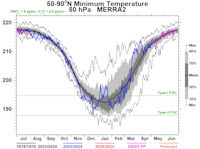
On Oct. 26, 2024, the Arctic stratosphere is much too warm for Type II polar stratospheric clouds. | more data. Noctilucent Clouds
The northern season for NLCs is underway--but not for long. The first clouds were detected inside the Arctic Circle on May 25, 2024, by the NOAA 21 satellite. After peaking in July, the clouds are now in rapid decline. This is typical for the month of August, which usually brings the end of NLC season in the northern hemisphere.
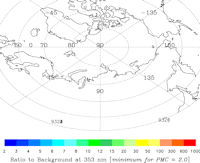
Updated: Aug. 28, 2024
An instrument onboard NOAA 21 (OMPS LP) is able to detect NLCs (also known as "polar mesospheric clouds" or PMCs). In the daily map, above, each dot is a detected cloud. As the season progresses, these dots will multiply in number and shift in hue from blue to red as the brightness of the clouds intensifies.
 SPACE WEATHER
NOAA Forecasts | | Updated at: 2024 Oct 28 2200 UTC FLARE | 0-24 hr | 24-48 hr | CLASS M | 75 % | 75 % | CLASS X | 30 % | 30 % |  Geomagnetic Storms: Geomagnetic Storms:
Probabilities for significant disturbances in Earth's magnetic field are given for three activity levels: active, minor storm, severe storm Updated at: 2024 Oct 28 2200 UTC Mid-latitudes | 0-24 hr | 24-48 hr | ACTIVE | 35 % | 20 % | MINOR | 15 % | 05 % | SEVERE | 05 % | 01 % | High latitudes | 0-24 hr | 24-48 hr | ACTIVE | 10 % | 15 % | MINOR | 20 % | 30 % | SEVERE | 50 % | 25 % | | | |  | | | | | | | | | | | This is an AI Free Zone! Text created by Large Language Models is spreading rapidly across the Internet. It's well-written, artificial, frequently inaccurate. If you find a mistake on Spaceweather.com, rest assured it was made by a real human being. | | | CME SPARKS MINOR GEOMAGNETIC STORM: As predicted, a CME propelled by Saturday's X1.8-class solar flare hit Earth today (Oct. 28th @ 0450 UTC). The impact sparked a minor G1-class geomagnetic storm, but no widespread display of auroras. CME impact alerts: SMS Text THE SUN JUST SWALLOWED A COMET: The solar system has one less comet. Comet ATLAS (C/2024 S1) melted away today when it passed within 0.008 AU of the sun. Coronagraphs onboard the Solar and Heliospheric Observatory witnessed the final moments: 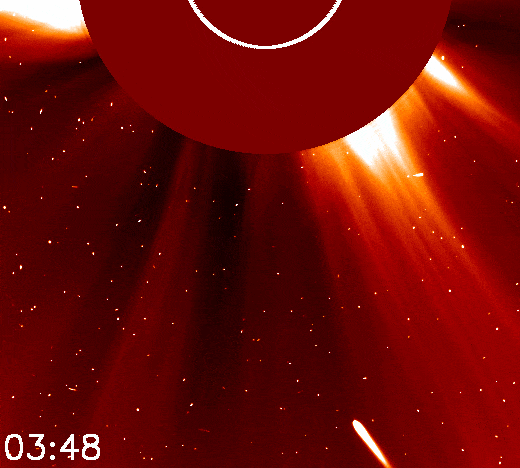
In the movie, an opaque disk covers the sun, blocking its glare to produce an artificial eclipse. This allowed SOHO's digital cameras to see the comet only 550,000 km from the surface of the sun. Comet ATLAS is a Kreutz sungrazer, a family of comets which are fragments from the breakup of a single giant comet ~1000 years ago. SOHO has discovered thousands of them, almost all disintegrating near the sun. The end of Comet ATLAS is a disapointment. When it first appeared in September, an outburst brightened the comet, making it appear larger than average Kreutz fragments. Many astronomers hoped it would survive the sun and put on a magnificent display like Kreutz Comet Ikeya-Seki did in 1965. Maybe next time :) Realtime Comet Photo Gallery
Free: Spaceweather.com Newsletter THE GEOMAGNETIC MOONCAT: This cat has experienced a geomagnetic storm. Multiple CMEs hit Earth's magnetic field during the weekend of August 10-11. Students of Earth to Sky Calculus launched a cosmic ray balloon into the resulting severe geomagnetic storm. The Geomagnetic Mooncat went along for the ride: 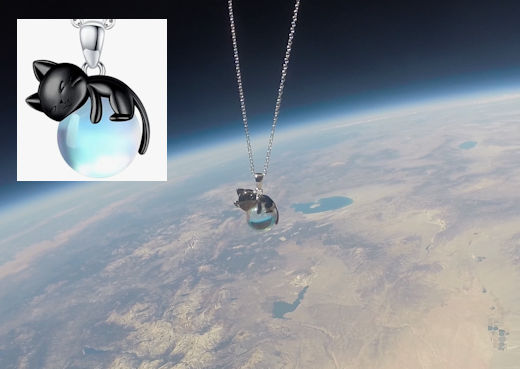
You can have it for $199.95. Supported by a sterling silver frame, the black cat is curled around a genuine blue moonstone. It floated through the stratosphere for almost 3 hours during the storm, gathering radiation data for the students' monitoring program. The Mooncat comes with a greeting card showing the pendant in flight and explaining the radiation experiment. The students of Earth to Sky Calculus are selling space jewelry to support their cosmic ray ballooning program. Don't wait for Christmas--get yours now! Far Out Gifts: Earth to Sky Store
All sales support hands-on STEM education MEANWHILE, COMET TSUCHINSHAN-ATLAS: Comet ATLAS (C/2024 S1) may be gone, but Comet Tsuchinshan-ATLAS (C/2023 A3) is still with us. Wioleta Gorecka photographed it Saturday night (Oct. 26th) from Vik, Iceland: 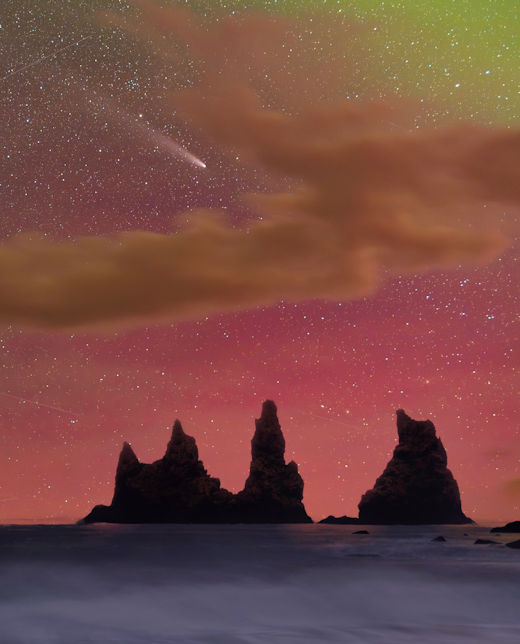
"My plan was to photograph only the comet, but the aurora had a different plan," says Gorecka. A CME struck during her photoshoot, igniting a wave of auroras arpound the Arctic Circle. "Pink and red dominated the entire sky." Comet Tsuchinshan-ATLAS has faded since its urban-bright display in mid-October, but it is still a great target for night sky photographers. Shining like a 5th magnitude star, the comet shows up nicely in exposures optimized for auroras and the Milky Way. Realtime Space Weather Photo Gallery
Free: Spaceweather.com Newsletter
Realtime Aurora Photo Gallery
Free: Spaceweather.com Newsletter
Every night, a network of NASA all-sky cameras scans the skies above the United States for meteoritic fireballs. Automated software maintained by NASA's Meteoroid Environment Office calculates their orbits, velocity, penetration depth in Earth's atmosphere and many other characteristics. Daily results are presented here on Spaceweather.com. On 0ct 27, 2024, the network reported 19 fireballs.
(15 sporadics, 4 Orionids) 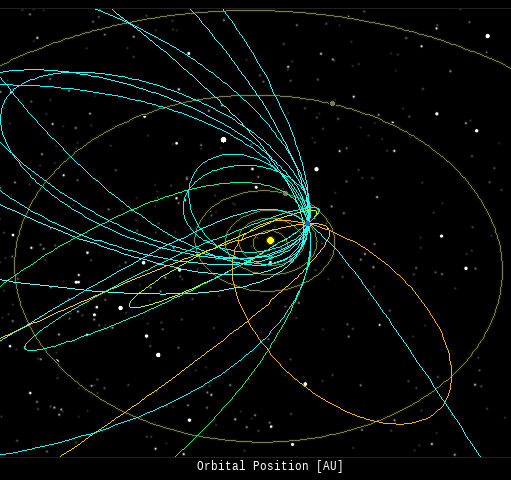 In this diagram of the inner solar system, all of the fireball orbits intersect at a single point--Earth. The orbits are color-coded by velocity, from slow (red) to fast (blue). [Larger image] [movies] Potentially Hazardous Asteroids ( PHAs) are space rocks larger than approximately 100m that can come closer to Earth than 0.05 AU. None of the known PHAs is on a collision course with our planet, although astronomers are finding new ones all the time. On October 28, 2024 there were 2349 potentially hazardous asteroids.
 | Recent & Upcoming Earth-asteroid encounters: | Asteroid | Date(UT) | Miss Distance | Velocity (km/s) | Diameter (m) | | 2024 UK2 | 2024-Oct-23 | 7.6 LD | 8.3 | 10 | | 2024 UR5 | 2024-Oct-23 | 5.6 LD | 19 | 33 | | 2024 UH4 | 2024-Oct-23 | 5.4 LD | 16.7 | 15 | | 2024 UT3 | 2024-Oct-23 | 18.6 LD | 8.9 | 69 | | 2024 UT | 2024-Oct-23 | 0.1 LD | 11.6 | 4 | | 2024 UJ1 | 2024-Oct-24 | 9 LD | 12.2 | 16 | | 2015 HM1 | 2024-Oct-24 | 14.4 LD | 10.9 | 32 | | 2024 TP17 | 2024-Oct-24 | 12.1 LD | 5.8 | 54 | | 2024 UQ3 | 2024-Oct-24 | 2.3 LD | 6.8 | 5 | | 363305 | 2024-Oct-24 | 11.8 LD | 4.9 | 186 | | 2024 TR6 | 2024-Oct-24 | 14.8 LD | 15.2 | 48 | | 2024 UB5 | 2024-Oct-24 | 2.9 LD | 11 | 8 | | 2024 UY | 2024-Oct-24 | 0.8 LD | 10.6 | 5 | | 2023 TG14 | 2024-Oct-24 | 6.6 LD | 6.9 | 24 | | 2021 UE2 | 2024-Oct-24 | 13.8 LD | 7.1 | 40 | | 2022 UV21 | 2024-Oct-25 | 6 LD | 8.9 | 16 | | 2024 TB2 | 2024-Oct-26 | 3.1 LD | 2.9 | 35 | | 2024 UN2 | 2024-Oct-26 | 0.6 LD | 10.5 | 21 | | 2007 UT3 | 2024-Oct-26 | 17.7 LD | 10.4 | 23 | | 2024 US5 | 2024-Oct-27 | 18.6 LD | 7.9 | 17 | | 2016 BF1 | 2024-Oct-27 | 10.4 LD | 9.2 | 30 | | 2024 UF4 | 2024-Oct-28 | 4.9 LD | 13.5 | 11 | | 2024 SE26 | 2024-Oct-28 | 9.8 LD | 12.6 | 106 | | 2024 UQ1 | 2024-Oct-28 | 0.6 LD | 6.6 | 10 | | 2020 WG | 2024-Oct-28 | 8.7 LD | 9.4 | 160 | | 2024 UX | 2024-Oct-28 | 7.3 LD | 4.7 | 10 | | 2024 UT2 | 2024-Oct-28 | 6.3 LD | 8.9 | 15 | | 2024 UO4 | 2024-Oct-28 | 0.2 LD | 8.4 | 3 | | 2024 UO2 | 2024-Oct-28 | 8.9 LD | 5 | 10 | | 2024 UO5 | 2024-Oct-28 | 1.4 LD | 10.2 | 5 | | 2024 UT4 | 2024-Oct-28 | 8.5 LD | 8.3 | 11 | | 2024 SU13 | 2024-Oct-29 | 10.9 LD | 6 | 32 | | 2024 UQ2 | 2024-Oct-30 | 4.3 LD | 14.9 | 22 | | 2024 UE3 | 2024-Oct-30 | 3.1 LD | 13.8 | 16 | | 2021 CV1 | 2024-Oct-30 | 14.4 LD | 23.6 | 38 | | 2024 UU1 | 2024-Oct-31 | 1.3 LD | 18 | 22 | | 2023 KX3 | 2024-Oct-31 | 18.8 LD | 2.4 | 25 | | 2024 UP4 | 2024-Oct-31 | 3.2 LD | 10.9 | 12 | | 2022 UD21 | 2024-Oct-31 | 11.4 LD | 11.8 | 27 | | 2024 UT5 | 2024-Nov-01 | 3.3 LD | 14.4 | 7 | | 2016 VA | 2024-Nov-01 | 1.5 LD | 21.2 | 11 | | 2024 UP5 | 2024-Nov-02 | 11.5 LD | 6.6 | 30 | | 2024 TX13 | 2024-Nov-03 | 1.9 LD | 7.6 | 41 | | 2020 VX1 | 2024-Nov-03 | 19.4 LD | 7.8 | 93 | | 2023 VS | 2024-Nov-04 | 15.2 LD | 4.3 | 4 | | 2024 UF2 | 2024-Nov-04 | 19.5 LD | 12.8 | 47 | | 2024 TD22 | 2024-Nov-05 | 8 LD | 11.9 | 51 | | 2024 UH5 | 2024-Nov-05 | 1.6 LD | 6.9 | 15 | | 2024 UW | 2024-Nov-06 | 1.7 LD | 4.7 | 9 | | 2022 JM | 2024-Nov-06 | 19.7 LD | 6.2 | 6 | | 2024 UU4 | 2024-Nov-09 | 19.7 LD | 5.6 | 15 | | 2024 UZ | 2024-Nov-10 | 16.4 LD | 4.9 | 19 | | 2024 UC3 | 2024-Nov-10 | 11 LD | 6.7 | 27 | | 2019 WB7 | 2024-Nov-11 | 17.3 LD | 5.7 | 43 | | 2024 UE4 | 2024-Nov-12 | 3.4 LD | 12.4 | 28 | | 2020 UL3 | 2024-Nov-12 | 4.1 LD | 10.5 | 80 | | 2020 AB2 | 2024-Nov-13 | 18.9 LD | 7.2 | 14 | | 2019 VU5 | 2024-Nov-14 | 12 LD | 23.3 | 46 | | 2019 VL5 | 2024-Nov-14 | 9.6 LD | 8.5 | 24 | | 2024 UC5 | 2024-Nov-17 | 10.8 LD | 4.3 | 19 | | 2023 WK3 | 2024-Nov-18 | 16.1 LD | 14.5 | 272 | | 2012 KO11 | 2024-Nov-20 | 6.2 LD | 9.4 | 43 | | 2020 VX4 | 2024-Nov-20 | 10.5 LD | 10.5 | 11 | | 2009 WB105 | 2024-Nov-25 | 15.1 LD | 18.9 | 71 | | 2006 WB | 2024-Nov-26 | 2.3 LD | 4.2 | 98 | | 2018 DC4 | 2024-Nov-29 | 18.8 LD | 4.5 | 12 | | 2019 JN2 | 2024-Nov-30 | 9.4 LD | 7.7 | 25 | | 2021 XZ | 2024-Dec-02 | 13.2 LD | 7.4 | 8 | | 447755 | 2024-Dec-03 | 14.4 LD | 12.2 | 402 | | 2020 XR | 2024-Dec-04 | 5.8 LD | 12.3 | 388 | | 2021 WA5 | 2024-Dec-05 | 9.8 LD | 5.9 | 12 | | 2024 UU3 | 2024-Dec-08 | 16.9 LD | 4.8 | 36 | | 2018 XU3 | 2024-Dec-11 | 16.8 LD | 10.8 | 28 | | 2007 XB23 | 2024-Dec-11 | 1.2 LD | 4.8 | 14 | | 2022 YO1 | 2024-Dec-17 | 2 LD | 14.3 | 4 | | 2020 XY4 | 2024-Dec-19 | 12.8 LD | 8.8 | 14 | Notes: LD means "Lunar Distance." 1 LD = 384,401 km, the distance between Earth and the Moon. 1 LD also equals 0.00256 AU. | | Cosmic Rays in the Atmosphere | SPACE WEATHER BALLOON DATA: Almost once a week, Spaceweather.com and the students of Earth to Sky Calculus fly space weather balloons to the stratosphere over California. These balloons are equipped with sensors that detect secondary cosmic rays, a form of radiation from space that can penetrate all the way down to Earth's surface. Our monitoring program has been underway without interruption for 7 years, resulting in a unique dataset of in situ atmospheric measurements. Latest results (July 2022): Atmospheric radiation is decreasing in 2022. Our latest measurements in July 2022 registered a 6-year low: 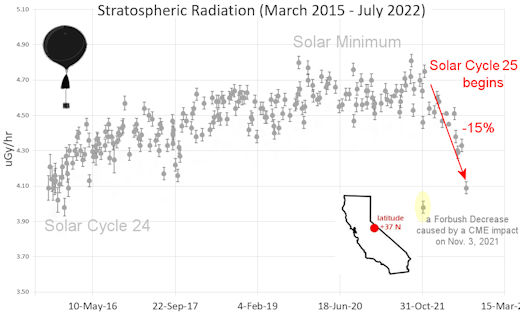
What's going on? Ironically, the radiation drop is caused by increasing solar activity. Solar Cycle 25 has roared to life faster than forecasters expected. The sun's strengthening and increasingly tangled magnetic field repels cosmic rays from deep space. In addition, solar coronal mass ejections (CMEs) sweep aside cosmic rays, causing sharp reductions called "Forbush Decreases." The two effects blend together to bring daily radiation levels down. .Who cares? Cosmic rays are a surprisingly "down to Earth" form of space weather. They can alter the chemistry of the atmosphere, trigger lightning, and penetrate commercial airplanes. According to a study from the Harvard T.H. Chan school of public health, crews of aircraft have higher rates of cancer than the general population. The researchers listed cosmic rays, irregular sleep habits, and chemical contaminants as leading risk factors. A number of controversial studies (#1, #2, #3, #4) go even further, linking cosmic rays with cardiac arrhythmias and sudden cardiac death. Technical notes: The radiation sensors onboard our helium balloons detect X-rays and gamma-rays in the energy range 10 keV to 20 MeV. These energies span the range of medical X-ray machines and airport security scanners. Data points in the graph labeled "Stratospheric Radiation" correspond to the peak of the Regener-Pfotzer maximum, which lies about 67,000 feet above central California. When cosmic rays crash into Earth's atmosphere, they produce a spray of secondary particles that is most intense at the entrance to the stratosphere. Physicists Eric Regener and Georg Pfotzer discovered the maximum using balloons in the 1930s and it is what we are measuring today. | | The official U.S. government space weather bureau | | | The first place to look for information about sundogs, pillars, rainbows and related phenomena. | | | Researchers call it a "Hubble for the sun." SDO is the most advanced solar observatory ever. | | | 3D views of the sun from NASA's Solar and Terrestrial Relations Observatory | | | Realtime and archival images of the Sun from SOHO. | | | information about sunspots based on the latest NOAA/USAF Active Region Summary | | | current counts of failed and deployed Starlink satellites from Jonathan's Space Page. See also, all satellite statistics. | | | Authoritative predictions of space junk and satellite re-entries | | | from the NOAA Space Environment Center | | | fun to read, but should be taken with a grain of salt! Forecasts looking ahead more than a few days are often wrong. | | | from the NOAA Space Environment Center | | | the underlying science of space weather |  | Got a chipped or cracked windshield that prevents you from seeing space weather events while driving? Get windshield replacement from SR Windows & Glass with free mobile auto glass service anywhere in the Phoenix area. |  | BestCSGOGambling is the best site for everything related to CSGO gambling on the web | | | These links help Spaceweather.com stay online. Thank you to our supporters! | | | | | | | | |  | |  |   | ©2021 Spaceweather.com. All rights reserved. This site is penned daily by Dr. Tony Phillips. | |

